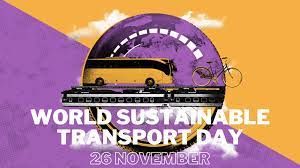
The United Nations General Assembly, in a decisive move towards fostering sustainable and environmentally friendly transportation, has designated November 26 as World Sustainable Transport Day. This resolution underscores the critical role of transport in connectivity, trade, economic growth, and employment, while acknowledging its significant contribution to greenhouse gas emissions. The pursuit of sustainable transport is not only an environmental imperative but a key strategy for achieving broader sustainable development goals.
World Sustainable Transport Day 2023 Theme
World Sustainable Transport Day 2023 focuses on the theme “Sustainable transport, sustainable development”.
Defining Sustainable Transport
Sustainable transport, as articulated by the Secretary-General’s High-level Advisory Group in 2016, encompasses the provision of services and infrastructure for the mobility of people and goods. It aims to advance economic and social development in a manner that is safe, affordable, accessible, efficient, and resilient. Crucially, sustainable transport seeks to minimize carbon and other emissions, as well as environmental impacts. It is not an end in itself but a means to achieve sustainable development.
Sustainable Transport and Development Objectives
Sustainable transport is positioned at the core of sustainable development, with objectives including universal access, enhanced safety, reduced environmental and climate impact, improved resilience, and greater efficiency. Beyond the provision of services and infrastructure, sustainable transport serves as a cross-cutting accelerator, facilitating progress towards crucial goals such as poverty eradication, inequality reduction, women empowerment, and climate change mitigation.
Significance of World Sustainable Transport Day
World Sustainable Transport Day holds immense significance in addressing critical global challenges related to transportation. It serves as a platform to:
Ø Promote Sustainable Transport Practices: WSTD encourages the adoption of sustainable transport modes, such as public transportation, cycling, and walking, to reduce reliance on fossil fuels and mitigate climate change.
Ø Improve Road Safety: WSTD promotes road safety measures to reduce the number of traffic-related injuries and fatalities.
Ø Enhance Air Quality: WSTD advocates for the use of cleaner fuels and technologies to reduce air pollution from transportation emissions.
Ø Address Urban Mobility Challenges: WSTD seeks to address congestion and mobility challenges in cities by promoting sustainable urban transport systems.
Ø Promote Inclusive Transportation: WSTD emphasizes the need for accessible and affordable transportation options for all, including people with disabilities, women, and children.
History of World Sustainable Transport Day
World Sustainable Transport Day (WSTD) was established by the United Nations General Assembly in its resolution A/RES/77/286, adopted on May 31, 2023. The resolution recognized the critical role of sustainable transport systems in achieving the Sustainable Development Goals (SDGs), including poverty eradication, climate action, good health and well-being, and sustainable cities and communities.
The proposal for WSTD was initiated by Turkmenistan, which recognized the importance of transport in connecting people, facilitating trade, and supporting economic growth. The resolution called upon all Member States, the United Nations system, and other relevant stakeholders to observe WSTD annually on November 26th to raise awareness and promote action towards sustainable transport.
Important Questions Related to Exam
1. Why did the United Nations General Assembly designate November 26 as World Sustainable Transport Day?
Solution: The General Assembly designated November 26 as World Sustainable Transport Day to emphasize the importance of fostering sustainable and environmentally friendly transportation. This decision recognizes the critical role of transport in connectivity, trade, economic growth, and employment while acknowledging its significant contribution to greenhouse gas emissions.
2. How is sustainable transport defined according to the Secretary-General’s High-level Advisory Group in 2016?
Solution: Sustainable transport, as defined by the Secretary-General’s High-level Advisory Group in 2016, encompasses the provision of services and infrastructure for the mobility of people and goods. It aims to advance economic and social development in a manner that is safe, affordable, accessible, efficient, and resilient. Importantly, sustainable transport seeks to minimize carbon and other emissions, as well as environmental impacts.





